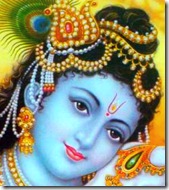 “Shri Krishna’s complexion is as polished as powdered eye ointment. It surpasses the beauty of a newly formed cloud and is softer than a blue lotus flower. Indeed, His complexion is so pleasing that it attracts the eyes and minds of everyone, and it is so powerful that it defies all comparison.” (Lord Chaitanya, Chaitanya Charitamrita, Antya 15.64)
“Shri Krishna’s complexion is as polished as powdered eye ointment. It surpasses the beauty of a newly formed cloud and is softer than a blue lotus flower. Indeed, His complexion is so pleasing that it attracts the eyes and minds of everyone, and it is so powerful that it defies all comparison.” (Lord Chaitanya, Chaitanya Charitamrita, Antya 15.64)
Question: “Is Krishna really blue?”
Answer: It certainly seems strange that followers of the Vedic tradition would worship a God who appears bluish. After all, we’ve never encountered anyone who had this appearance in our worldly affairs. In fact, the term “black and blue” refers to the appearance of a bruise, which is a mark seen on the surface of the body after it has been hurt in some way. Yet the followers of the Vedic tradition didn’t just concoct this idea of a blue God, but rather they take it from authority that the Supreme Personality of Godhead indeed has an ever-existing, transcendental form, which is the most beautiful and most attractive in all the worlds. The highest bliss, transcendental or otherwise, can be realized by regularly drinking the sweet mellows of this divine vision.
 The common misconception is that Hindus believe in many gods. There are certainly many godlike figures such as Ganesha, Shiva, Brahma, and Durga, but such personalities merely represent the height of material opulence in the mode of goodness. In essence, these divine figures, who are worthy of the highest respect and adoration from mankind, represent the Supreme Lord’s close family, His faithful servants and deputies. The Supreme Lord is singular, so He is one without a second. In many spiritual disciplines this singular divine entity is known by the name of God, but the Vedas don’t limit the Supreme Lord to only one name. Rather, He can be addressed through limitless, unique sound vibrations which each reference a specific attribute, pastime, or quality of the Lord. Since the Lord enacts so many pastimes, He takes many different forms, some visible and some not. Several of these forms kindly descend to earth from time to time, while others remain in the spiritual sky for the benefit of the eternally liberated associates. Though there are countless forms – as many as there are waves in the ocean – there is still a fountainhead, an original from which all others emanate. This original personality is Krishna.
The common misconception is that Hindus believe in many gods. There are certainly many godlike figures such as Ganesha, Shiva, Brahma, and Durga, but such personalities merely represent the height of material opulence in the mode of goodness. In essence, these divine figures, who are worthy of the highest respect and adoration from mankind, represent the Supreme Lord’s close family, His faithful servants and deputies. The Supreme Lord is singular, so He is one without a second. In many spiritual disciplines this singular divine entity is known by the name of God, but the Vedas don’t limit the Supreme Lord to only one name. Rather, He can be addressed through limitless, unique sound vibrations which each reference a specific attribute, pastime, or quality of the Lord. Since the Lord enacts so many pastimes, He takes many different forms, some visible and some not. Several of these forms kindly descend to earth from time to time, while others remain in the spiritual sky for the benefit of the eternally liberated associates. Though there are countless forms – as many as there are waves in the ocean – there is still a fountainhead, an original from which all others emanate. This original personality is Krishna.
The Sanskrit word “Krishna” has several different meanings. It can mean “dark”, or “blackish”. It can also mean “all-attractive.” Since the original Divine Entity possesses both of these attributes, Krishna is the most appropriate name for Him. The Supreme Lord is the most attractive person in existence, and attraction to Him is anything but fatal. Attraction to beautiful men and women can be damaging in the sense that it can lure a person into doing something they otherwise wouldn’t do. In this respect, enchantment can lead to loss of rationale and the taking to harmful activities. For those who associate directly with the original transcendental, all-attractive form of the Lord, there is no risk of danger because there is no illusion or detrimental enchantment. Rather, it is the essential characteristic of the spirit soul to be a lover of Krishna, so once this soul is reunited with its Divine Lovable Object, it immediately regains its infinite knowledgeable and blissful position.
“Krishna’s bodily complexion is very similar to the bluish hue of a cloud, so simply by observing a bluish cloud, Shrimati Radharani remembered Him.” (Shrila Prabhupada, The Nectar of Devotion, Ch 30)
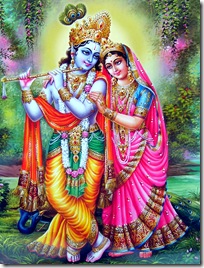 How do we know what Krishna looks like? Just as with any other important piece of information, knowledge of Krishna is taken from authority. Those who have seen Him personally have shared their experiences with others and also written them down in books. This information has been since passed down from generation to generation. Additionally, houses of worship have been erected which depict the Lord in His various forms, performing different activities. Through consultation with such authorized information, we come to understand what Krishna looks like, what makes Him happy and what doesn’t, and moreover, what it takes to gain His association.
How do we know what Krishna looks like? Just as with any other important piece of information, knowledge of Krishna is taken from authority. Those who have seen Him personally have shared their experiences with others and also written them down in books. This information has been since passed down from generation to generation. Additionally, houses of worship have been erected which depict the Lord in His various forms, performing different activities. Through consultation with such authorized information, we come to understand what Krishna looks like, what makes Him happy and what doesn’t, and moreover, what it takes to gain His association.
“The shyama color is not exactly blackish. Shrila Bhaktisiddhanta Sarasvati Thakura compares it to the color of the atasi flower. It is not that Lord Krishna Himself appears in a blackish color in all the Dvapara-yugas. In other Dvapara-yugas, previous to Lord Krishna’s appearance, the Supreme Lord appeared in a greenish body by His own personal expansion. This is mentioned in the Vishnu Purana, Hari-vamsha and Mahabharata.” (Shrila Prabhupada, Chaitanya Charitamrita, Madhya 20.337 Purport)
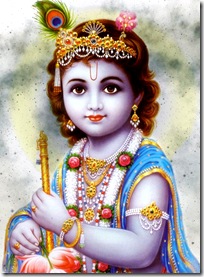 While it seems strange that Krishna would be blue in color, the exact characterization of His complexion is that of a dark raincloud. The Lord is described as shyama, which can mean dark, bluish, greenish, like the color of the Tamala tree, or more simply like the dark-blue raincloud. Since Krishna is exquisitely beautiful, another one of His names is Shyamasundara. The descriptions of the Lord’s personal appearances found in sacred texts like the Shrimad Bhagavatam and Mahabharata are incredibly accurate in that the compilers of these works didn’t just create a new color on their own which could be misconstrued in the future. Rather, they carefully observed nature around them and found those things which matched Krishna’s appearance. Of all the objects they observed, nothing came closer to matching up with Krishna’s complexion than the dark raincloud.
While it seems strange that Krishna would be blue in color, the exact characterization of His complexion is that of a dark raincloud. The Lord is described as shyama, which can mean dark, bluish, greenish, like the color of the Tamala tree, or more simply like the dark-blue raincloud. Since Krishna is exquisitely beautiful, another one of His names is Shyamasundara. The descriptions of the Lord’s personal appearances found in sacred texts like the Shrimad Bhagavatam and Mahabharata are incredibly accurate in that the compilers of these works didn’t just create a new color on their own which could be misconstrued in the future. Rather, they carefully observed nature around them and found those things which matched Krishna’s appearance. Of all the objects they observed, nothing came closer to matching up with Krishna’s complexion than the dark raincloud.
Though we may not know anyone who possesses a bluish complexion today, we can most certainly witness the beautiful color of the cloud which is about to pour down rain. In fact, depending on the time and circumstance, one can see this cloud in the sky and immediately be reminded of Krishna. The great Vaishnava saint and poet, Goswami Tulsidas, described his mood of devotion and his ultimate conclusion in life by discussing the dark raincloud and a specific type of bird which is enamored by it. While Krishna is the original form of Godhead, His direct expansion is Lord Vishnu, who possesses a similar complexion but is more opulently dressed and possesses four hands instead of two. Vishnu then incarnates into various forms which appear on earth. Among Vishnu’s chief incarnations, probably the most celebrated is Lord Rama, the handsome and pious prince of Ayodhya who roamed the earth many thousands of years ago. Tulsidas was especially devoted to Rama, though he made no distinctions between Rama, Vishnu, and Krishna. All three have the same bodily complexion, for even Maricha, an infamous Rakshasa demon, describes in the Ramayana that Rama’s body is of the shyama complexion.
“At the time, there were not yet visible any signs of manhood on the boy’s beautiful face, which was dark-blue in complexion [shyama] and had an all-auspicious gaze. Rama had a gold chain round His neck, a small tuft of hair on His head, wore only one piece of clothing, and held a bow in His hands.” (Maricha speaking to Ravana about Rama during His youth, Valmiki Ramayana, Aranya Kand, 38.14)
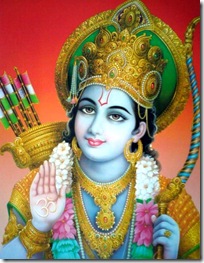 When a person is on the highest platform of transcendental love, they lose interest in all the terms and concepts associated with the study of self-realization and religion. In this topmost stage, the pure devotee is only interested in associating with the Supreme Lord in a loving way, so there is no concern for adherence to rules of etiquette or specific terms of spiritual practice. Advanced terminology and vocabulary are difficult to comprehend for the average person, so poets often prefer using analogies and similes to explain high concepts. Tulsidas, in attempting to describe his love for Rama, makes a comprehensive comparison to the Chatak bird. Descriptions of this comparison are found in his Dohavali. In this work, Tulsidas states his desire to be just like the Chatak bird, which only drinks rain water. This bird is praised because its beak is constantly faced upwards while it stares at the dark raincloud. This cloud bears the closest resemblance to Rama [Krishna], so Tulsidas praises the bird for its level of devotion. Since the bird only drinks the water poured down from this cloud, Tulsidas states that for the bird’s benefit, it is better for it not to rain. Rather, if only a few raindrops fall every now and then, the level of love and devotion shown by the bird will remain intact. If the raincloud shows too much direct affection to the Chatak in the form of showers of rain, the bird might become lax in its devotion and start to view its lovable object as an order supplier. Pure love is practiced when there is absolutely no expectation of reciprocation.
When a person is on the highest platform of transcendental love, they lose interest in all the terms and concepts associated with the study of self-realization and religion. In this topmost stage, the pure devotee is only interested in associating with the Supreme Lord in a loving way, so there is no concern for adherence to rules of etiquette or specific terms of spiritual practice. Advanced terminology and vocabulary are difficult to comprehend for the average person, so poets often prefer using analogies and similes to explain high concepts. Tulsidas, in attempting to describe his love for Rama, makes a comprehensive comparison to the Chatak bird. Descriptions of this comparison are found in his Dohavali. In this work, Tulsidas states his desire to be just like the Chatak bird, which only drinks rain water. This bird is praised because its beak is constantly faced upwards while it stares at the dark raincloud. This cloud bears the closest resemblance to Rama [Krishna], so Tulsidas praises the bird for its level of devotion. Since the bird only drinks the water poured down from this cloud, Tulsidas states that for the bird’s benefit, it is better for it not to rain. Rather, if only a few raindrops fall every now and then, the level of love and devotion shown by the bird will remain intact. If the raincloud shows too much direct affection to the Chatak in the form of showers of rain, the bird might become lax in its devotion and start to view its lovable object as an order supplier. Pure love is practiced when there is absolutely no expectation of reciprocation.
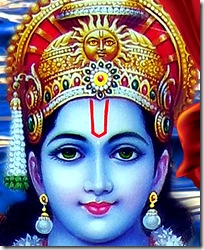 In this way, Goswami Tulsidas informs us that the dealings between the Chatak bird and the raincloud represent the highest level of spiritual practice. Tulsidas also states that the Chatak, as the object representing a pure devotee, teaches its dependents to not turn its beak away from the raincloud even at the time of death or when the last rites are performed. This shows that Tulsidas believes that thinking of Rama at all times, even when one is about to die, is the highest religious practice. Moreover, he wanted to make sure that future generations knew exactly what his primary dharma in life was. He only wanted to look at the beautiful body of the Lord and never think of anything or anyone else. This behavior represents love in the mood of separation, a method which provides the topmost bliss to both the giver and the receiver. Shri Rama is satisfied by the devotee who is always looking at Him with loyalty, dedication, and love. The Chatak bird renounces all kith and kin and refuses to accept any other water except that which emanates from its beloved raincloud. In the same manner, the pure devotee refuses to acknowledge the existence of anything not directly related to Krishna. The devotee only humbly accepts prasadam, or the Lord’s mercy, even though there is no expectation or desire for this mercy. In the highest stage of transcendental love, the separated devotee derives the greatest pleasure simply by offering their love without motive.
In this way, Goswami Tulsidas informs us that the dealings between the Chatak bird and the raincloud represent the highest level of spiritual practice. Tulsidas also states that the Chatak, as the object representing a pure devotee, teaches its dependents to not turn its beak away from the raincloud even at the time of death or when the last rites are performed. This shows that Tulsidas believes that thinking of Rama at all times, even when one is about to die, is the highest religious practice. Moreover, he wanted to make sure that future generations knew exactly what his primary dharma in life was. He only wanted to look at the beautiful body of the Lord and never think of anything or anyone else. This behavior represents love in the mood of separation, a method which provides the topmost bliss to both the giver and the receiver. Shri Rama is satisfied by the devotee who is always looking at Him with loyalty, dedication, and love. The Chatak bird renounces all kith and kin and refuses to accept any other water except that which emanates from its beloved raincloud. In the same manner, the pure devotee refuses to acknowledge the existence of anything not directly related to Krishna. The devotee only humbly accepts prasadam, or the Lord’s mercy, even though there is no expectation or desire for this mercy. In the highest stage of transcendental love, the separated devotee derives the greatest pleasure simply by offering their love without motive.
“My dear friend, please tell Me what I should do. Krishna is as attractive as a wonderful cloud, and My eyes are just like chataka birds, which are dying of thirst because they do not see such a cloud.” (Lord Chaitanya, Chaitanya Charitamrita, Antya 15.65)
 In order for this love to be practiced, the Supreme Lord, through His bodily complexion which is like that of the dark raincloud, must be a giver of Supreme transcendental pleasure. It is for this reason that the Vaishnavas, those who eventually disregard any and all mundane rules and regulations of religion, take to devotional service as their only engagement in life. Not only is Krishna’s appearance beautiful, but so are the transcendental sound vibrations of His various names. Just as the beautiful complexion of the raincloud brings sweet pleasure to the eyes of the Chatak bird, the names Krishna and Rama can bring the same level of pleasure to the ears of the love-starved conditioned living entities. Therefore, the highest engagement for the people of this age is to regularly chant the maha-mantra, “Hare Krishna Hare Krishna, Krishna Krishna, Hare Hare, Hare Rama Hare Rama, Rama Rama, Hare Hare”, while thinking of their beloved bluish Lord through separation.
In order for this love to be practiced, the Supreme Lord, through His bodily complexion which is like that of the dark raincloud, must be a giver of Supreme transcendental pleasure. It is for this reason that the Vaishnavas, those who eventually disregard any and all mundane rules and regulations of religion, take to devotional service as their only engagement in life. Not only is Krishna’s appearance beautiful, but so are the transcendental sound vibrations of His various names. Just as the beautiful complexion of the raincloud brings sweet pleasure to the eyes of the Chatak bird, the names Krishna and Rama can bring the same level of pleasure to the ears of the love-starved conditioned living entities. Therefore, the highest engagement for the people of this age is to regularly chant the maha-mantra, “Hare Krishna Hare Krishna, Krishna Krishna, Hare Hare, Hare Rama Hare Rama, Rama Rama, Hare Hare”, while thinking of their beloved bluish Lord through separation.
Worship of a personal God is condemned in many circles, but this restriction is certainly not authorized by the Vedas. After all, every person in this world is looking for pleasure, even the animals. If the Supreme Lord is lacking a transcendental form possessing full variegatedness, how can He please anyone? Moreover, if the form of the Personality of Godhead is denied, people will be more apt to worship those who do possess a form. This means that instead of worshiping God, man will worship dog. Actually this already happens, as people regularly bow down and serve their pets by picking up their waste deposits off of sidewalks and other public areas. And yet the bowing down to a deity form of the Supreme Lord is strictly condemned by religious leaders whose purported aim it is to bring transcendental pleasure, that which transcends the bonds of life and death, to the conditioned souls. This certainly doesn’t seem logical nor does it square with the constitutional position of the soul.
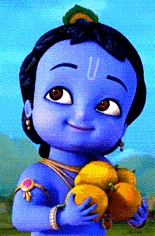 The Vedas tell us that this world is merely a shadow copy of the same realm that exists in the spiritual world. Since there is variegatedness in this world in the form of different bodies and material qualities, there certainly must be variety in the spiritual world. Otherwise, wherefrom has this variety come? If variety is absent in the spiritual world, how can it manifest in the material world? By denying the form of the Personality of Godhead and the variety of His activities and pastimes, the spiritual world is essentially deemed a place inferior to the material world. If the material world thus becomes superior, what need is there of entering the kingdom of God?
The Vedas tell us that this world is merely a shadow copy of the same realm that exists in the spiritual world. Since there is variegatedness in this world in the form of different bodies and material qualities, there certainly must be variety in the spiritual world. Otherwise, wherefrom has this variety come? If variety is absent in the spiritual world, how can it manifest in the material world? By denying the form of the Personality of Godhead and the variety of His activities and pastimes, the spiritual world is essentially deemed a place inferior to the material world. If the material world thus becomes superior, what need is there of entering the kingdom of God?
The point to religion, or a bona fide spiritual practice, is to find pleasure. Since we currently reside in a perverted copy of an original realm which is always pure, the enjoyment we experience is checked. Yet by kindly turning our heads towards the dark raincloud-like body of the Supreme Lord, the answer to all our problems can be found. Krishna is all-attractive, and anyone who associates with Him on a regular basis can attest to this fact. By taking to the worship of this bluish deity, the Raincloud of Transcendental Love will pour Its kind offerings on us all.
Comments
Hare Krishna!
Thank you for this beautiful explanation!
Hari Bol!! Jai Jagannath!!